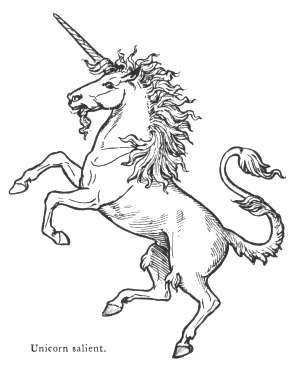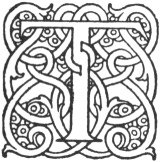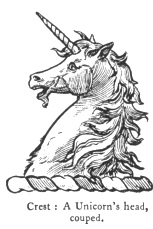
Masonic, Occult and Esoteric Online Library
Fictitious and Symbolic Creatures in Art
By John Vinycomb
Other Chimerical Creatures and Heraldic Beasts- The Unicorn

"Yon lion placed two unicorns between
That rampant with a silver sword is seen
Is for the king of Scotland's banner known."
Ariosto (Hoole's translation).
"The lion and the unicorn fighting for the crown."
Old Nursery Rhyme.
 THE unicorn is represented by heraldic usage as having the head and body of a horse, with the tail of a lion, and the limbs and hoofs of a stag; a twisted horn grows out from the centre of its forehead. It is rarely met with as a coat-of-arms. As a crest or supporter it is of more frequent occurrence. A unicorn's head is a favourite bearing, either erased, or couped, at the shoulder, and always represented in profile.
THE unicorn is represented by heraldic usage as having the head and body of a horse, with the tail of a lion, and the limbs and hoofs of a stag; a twisted horn grows out from the centre of its forehead. It is rarely met with as a coat-of-arms. As a crest or supporter it is of more frequent occurrence. A unicorn's head is a favourite bearing, either erased, or couped, at the shoulder, and always represented in profile.
The unicorn was a famous device all over Europe, and symbolised
 the virtue of the mind and the strength of the body. It is well known as a supporter of the Royal Arms of England, a position it has occupied since the accession of James VI. of Scotland to the English throne as James I. Two silver unicorns were the supporters to the arms of that kingdom. On the legislative union with England, the red dragon of Wales, introduced by Henry VII., gave place to the unicorn as the sinister supporter.
the virtue of the mind and the strength of the body. It is well known as a supporter of the Royal Arms of England, a position it has occupied since the accession of James VI. of Scotland to the English throne as James I. Two silver unicorns were the supporters to the arms of that kingdom. On the legislative union with England, the red dragon of Wales, introduced by Henry VII., gave place to the unicorn as the sinister supporter.
James III. of Scotland had it figured on coins which were thence called "unicorns." James V. first used it with the national arms as supporters. Although the silver unicorn came into England with James I., Queen Jane Seymour had already adopted it.
"Unicorn" was the pursuivant of Lord Lyon King-at-Arms, the Royal Scottish Herald.
As a supporter to the Royal arms it is thus blazoned: A unicorn argent, armed, unguled, crined and gorged or, with a royal coronet (i.e., composed of crosses patée and fleurs-de -lis), having a chain affixed thereto, and reflexed over his back of the last. The term "armed" has reference to his horn, "unguled" to his hoofs, and "crined" to his flowing mane. "Gorged" implies that the coronet encircles his "gorge" or throat. The term "or" (that is, the metal gold or the tincture of it) being only mentioned after the several parts implies that they are all alike to be gold. "Of the last" means of the last colour mentioned.
In "The History of Caricature and Grotesque in Literature and Art," by Thomas Wright, M.A., F.S.A. (p. 8), appears a curious illustration from an Egyptian papyrus of the Roman period, in the British Museum. It represents a lion and a unicorn playing a game resembling draughts, perhaps the earliest instance of the two animals depicted in conjunction. As the author says: "The lion has evidently gained the victory and is fingering the money; his bold air of swaggering superiority as well as the look of surprise and disappointment of his vanquished opponent are by no means ill-pictured."
The animosity which existed between the lion and unicorn is referred to by Spenser, and is allegorical of the animosity which once existed between England and Scotland:
"Like as a lyon whose imperiall powre
A proud rebellious unicorne defyes."
Faerie Queen, ii. 5.
Footnotes
127:* But for an oversight in the drawing, the unicorn should have been represented with the divided hoofs of a stag.
